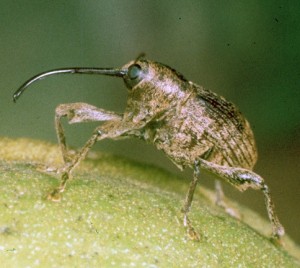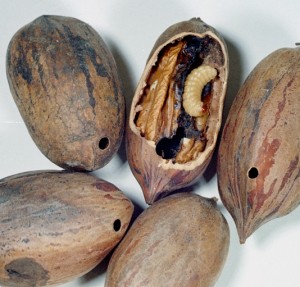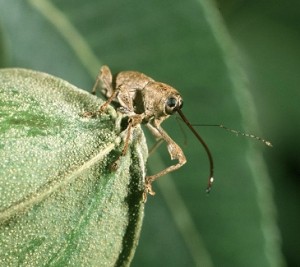Pecan Weevil
 Scientific Name
Scientific Name
Curculio caryae
Hosts
The only economic host is the pecan where feeding and breeding take place in the developing nuts. The pecan weevil will also breed in hickory nuts.
Symptoms
 When the adults emerge from the soil they feed on nuts by puncturing the shuck and
shell. If the nuts are still in the water stage, they lose fluid through the puncture
and fall from the tree two or three days later. These damaged nuts can be recognized
by the dark stains on the outside of the shuck. The main type of damage is caused
by larvae feeding within the nut. One to four larvae develop inside each nut and destroy
the entire kernel.
When the adults emerge from the soil they feed on nuts by puncturing the shuck and
shell. If the nuts are still in the water stage, they lose fluid through the puncture
and fall from the tree two or three days later. These damaged nuts can be recognized
by the dark stains on the outside of the shuck. The main type of damage is caused
by larvae feeding within the nut. One to four larvae develop inside each nut and destroy
the entire kernel.
Life Cycle
 Adult weevils may emerge from the soil from late July into October, often after rain
has softened the ground. Peak emergence is typically between August 10 and September
20. In years of extreme drought during August, peak emergence can be delayed until
September or even later. As they emerge, the weevils begin to feed on the pecan nuts
and mate. Egg laying begins when the weevils find nuts in the gel stage. The female
drills a hole in the nut with her snout and then places one to four eggs within the
developing kernel. Larvae hatch and feed on the kernel, maturing in about 30 days.
Maturity may be reached as early as September or as late as December. Mature larvae
chew a hole in the nut shell, fall to the ground, and burrow into the soil. They remain
in the soil as larvae for one year. Some of the larvae pupate from early September
to the middle of October the following year and change into adults about three weeks
later. The remaining larvae spend another year in the soil. Those changing to adults
remain in the soil until August or September of the following year before emerging.
The larvae that spend two years in the soil pupate and remain in the soil as adults
for a third year. One generation takes two or three years.
Adult weevils may emerge from the soil from late July into October, often after rain
has softened the ground. Peak emergence is typically between August 10 and September
20. In years of extreme drought during August, peak emergence can be delayed until
September or even later. As they emerge, the weevils begin to feed on the pecan nuts
and mate. Egg laying begins when the weevils find nuts in the gel stage. The female
drills a hole in the nut with her snout and then places one to four eggs within the
developing kernel. Larvae hatch and feed on the kernel, maturing in about 30 days.
Maturity may be reached as early as September or as late as December. Mature larvae
chew a hole in the nut shell, fall to the ground, and burrow into the soil. They remain
in the soil as larvae for one year. Some of the larvae pupate from early September
to the middle of October the following year and change into adults about three weeks
later. The remaining larvae spend another year in the soil. Those changing to adults
remain in the soil until August or September of the following year before emerging.
The larvae that spend two years in the soil pupate and remain in the soil as adults
for a third year. One generation takes two or three years.
Description
Adults are hard-shelled beetles with long slender snouts and thin legs. They are reddish brown to gray and about 1/2 inch long. The snout of the female is longer than the body while the males snout is slightly shorter than the body. A pair of long, elbowed antennae are attached at about the middle of the snout. The larvae are creamy white, legless grubs with soft, fleshy bodies and reddish brown heads.
Control
Please contact your local county extension office for current information.
